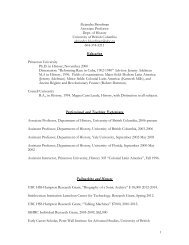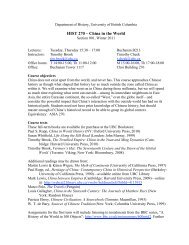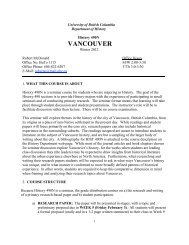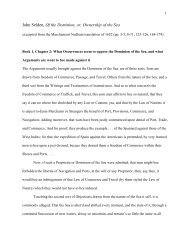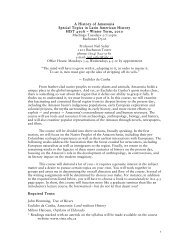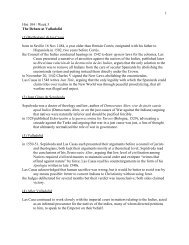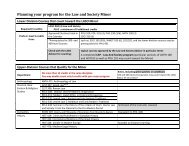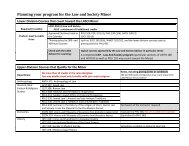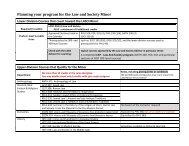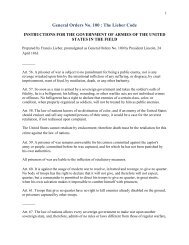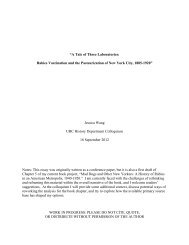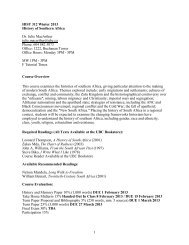Orientalizing the Pacific Rim: - History, Department of
Orientalizing the Pacific Rim: - History, Department of
Orientalizing the Pacific Rim: - History, Department of
Create successful ePaper yourself
Turn your PDF publications into a flip-book with our unique Google optimized e-Paper software.
The survey’s focus upon ‘Orientals’ had much to do with its missionary<br />
organizers. Davis, Gleason, and Fisher had begun <strong>the</strong>ir project because <strong>of</strong> <strong>the</strong>ir<br />
background in Japan and <strong>the</strong>ir concern over anti-Japanese agitation; <strong>the</strong>y had only<br />
expanded <strong>the</strong> focus <strong>of</strong> <strong>the</strong> survey to include <strong>the</strong> Chinese at a much later date.<br />
Strangely, this expansion was less in response to labor leaders, who no longer had<br />
much ‘problem’ with <strong>the</strong> Chinese, but to <strong>the</strong> many o<strong>the</strong>r missionaries who worked<br />
among <strong>the</strong> Chinese in both China and <strong>the</strong> United States. The definition <strong>of</strong> who in <strong>the</strong><br />
end was an ‘Oriental’ was intimately connected with <strong>the</strong> missionaries’ interest in <strong>the</strong><br />
Orient as <strong>the</strong> geographical location <strong>of</strong> <strong>the</strong>ir mission. They empathized with ‘Orientals’<br />
in America because <strong>the</strong>y viewed <strong>the</strong>m in <strong>the</strong> same way that <strong>the</strong>y viewed ‘Orientals’ in<br />
<strong>the</strong> Orient, as potential converts. Organizations such as <strong>the</strong> YMCA International and<br />
<strong>the</strong> American Board <strong>of</strong> Foreign Missions pr<strong>of</strong>essed a global vision <strong>of</strong> not only<br />
Christianization but Americanization, spreading <strong>the</strong> ‘good word’ about <strong>the</strong> American<br />
way <strong>of</strong> life, which <strong>the</strong>y saw as a concurrent goal. The Survey <strong>of</strong> Race Relations was<br />
only one step towards <strong>the</strong> remaking <strong>of</strong> <strong>the</strong> ‘Oriental’ at home, but it fit into <strong>the</strong><br />
broader attempt <strong>of</strong> remaking <strong>the</strong> ‘Oriental’ abroad. In his justification for <strong>the</strong> necessity<br />
<strong>of</strong> <strong>the</strong> survey, George Gleason explained <strong>the</strong> duty <strong>of</strong> <strong>the</strong> returned missionaries who<br />
were on <strong>the</strong> west coast:<br />
referred in 1919 to “Asiatic immigrants” by including Armenians and Syrians from<br />
“Western Asia” toge<strong>the</strong>r with Chinese and Japanese from “Eastern Asia.” By <strong>the</strong><br />
Survey <strong>of</strong> Race Relations five years later, he was referring more specifically to Chinese<br />
and Japanese as “Oriental immigrants.” The point is that <strong>the</strong> boundaries <strong>of</strong> <strong>the</strong><br />
definitions changed through time with <strong>the</strong> contexts and situations <strong>of</strong> usage. Emory S.<br />
Bogardus, Essentials <strong>of</strong> Americanization (Los Angeles: University <strong>of</strong> Sou<strong>the</strong>rn California<br />
Press, 1919, 2nd edition, 1920), 201.<br />
14



